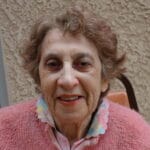
Tsylya Levitskaya (Ukraine)
I was born in Boguslav, Ukraine, on July 6, 1932. My family included my parents, my older brother Yefim, and me. My father, Moisey Levitskiy, worked as a salesman at a department store near Boguslav before the war. My mother, Braina Levitskaya (maiden name Strizsevskaya), worked as cashier at a bookstore in Boguslav.
When World War II began, my family was forced to move away from the city to find a safer location. My brother was 13 at the time and I was nine. In July 1941, our family got in a truck and went to the nearest railroad station, Mironovka. We gave up everything we had, taking only a few belongings that we carried in a bag. At Mironovka Station, near Kiev, we boarded a freight train and headed east towards Russia. Along the way, a German aircraft bombed the train after it had stopped, but we survived by hiding under the train. As we went deeper into Russia, we had to exchange our belongings for bits of bread and other food because we had nothing at all to eat.
We arrived to the Stalingrad area first (now called Volgograd), where we were given a small room in a Kolkhoz.[1] It was there that my father was called to serve in the Red Army. The Germans soon approached the Stalingrad area, so my mother, brother and I had to flee further to the east. We made it to a small village called Krotovka, located near Kuybyshev (now Samara), where we lived for four years until the war ended.
Throughout our years in evacuation, we had very little to eat. Even the collective farms in the area were very poor and could only give us small amounts of flour, milk, and vegetable oil. My mother used these ingredients to make flat bread for us, but it wasn’t enough. We suffered from hunger and cold. My brother and I couldn’t attend school every day because it was very cold and we didn’t have warm clothes or shoes.
My father was wounded during the war but returned to our family at war’s end. We moved back to Boguslav in 1945, but our old house was occupied by others by then and we had nowhere to live. We moved to Chernovtsy (in western Ukraine) in 1946, where my father found work and an apartment for us.
It took our family a long time to recover after the war. The post-war years in the Soviet Union were also very difficult, but we were lucky to survive. I went back to school and graduated in 1951. I didn’t pass the enrollment tests at a University so I got a job in an agriculture school laboratory (Chernovtsy Chemical Laboratory). I simultaneously enrolled in a correspondence program at the Institute of Agriculture. In 1953, I was accepted to the Tomsk Polytechnic Institute in the Electro-Mechanical Department. I graduated with honors in 1957. Qualified as an electrical engineer, I went to work at a factory in Novosibirsk that produced electronic components. In 1960, I switched to scientific work at the Siberian Scientific Research Institute of Energy.
In 1992, together with my brother and his family, I immigrated to the United States. I was happy to end up in Tucson, Arizona. I was familiar with the publications of Dr. James R. Wait, who worked at the University of Arizona in the electrical engineering and Geophysics (Geosciences) department. I read some of his publications in Novosibirsk, including his book “Geo-Electromagnetism.” Soon after my arrival, I met with Dr. Wait. I handed him the English translations of my articles, told him a little about my work. He became interested in the geophysical research performed in the former Soviet Union. He introduced me to Professor Ben K. Sternberg, director of the Laboratory for Advanced Subsurface Imaging (LASI). With Professor Ben K. Sternberg as co-author, we published five articles, mainly in the Radio Science magazine. Currently, along with Ben Stenberg, I am writing a book, “Electrical Spectroscopy in Earth Materials.”
[1] A Kolkhoz was a Soviet collective farm.
